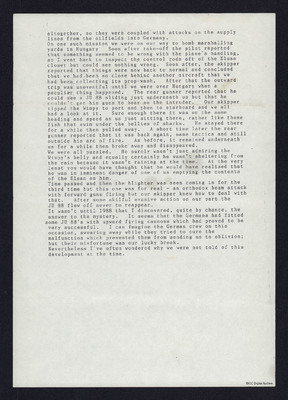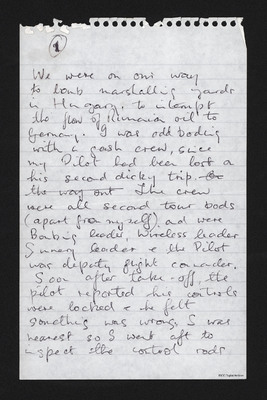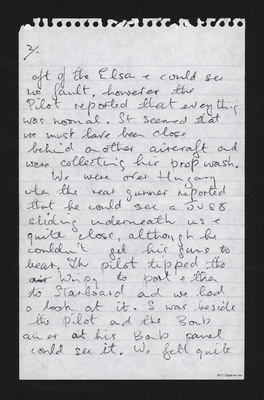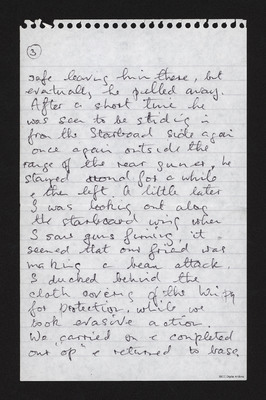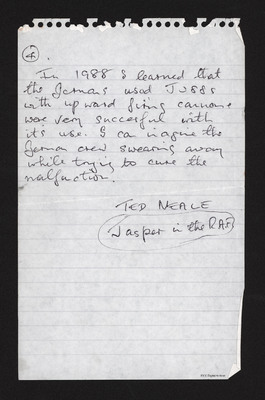Oil's Well
Title
Oil's Well
by Ted 'Jasper' Neale
Description
Discusses in detail an operation to attack the Ploesti oilfields in Romania. At that time he was based in Foggia, Italy. They had an issue with the airframe of the Wellington twisting due to a mismatch in the fuel tanks. On another operation a control issue was traced to propwash from another aircraft. On another operation a Ju 88 flew underneath them twice but its guns were stuck. It wasn't until 1988 that he discovered that the Ju88 had upward firing guns. Includes handwritten notes.
Creator
Language
Format
Two typewritten sheets and four handwritten sheets
Publisher
Rights
This content is available under a CC BY-NC 4.0 International license (Creative Commons Attribution-NonCommercial 4.0). It has been published ‘as is’ and may contain inaccuracies or culturally inappropriate references that do not necessarily reflect the official policy or position of the University of Lincoln or the International Bomber Command Centre. For more information, visit https://creativecommons.org/licenses/by-nc/4.0/ and https://ibccdigitalarchive.lincoln.ac.uk/omeka/legal.
Contributor
Identifier
BNealeETHNealeETHv030001,
BNealeETHNealeETHv030002,
BNealeETHNealeETHv040001,
BNealeETHNealeETHv040002,
BNealeETHNealeETHv040003,
BNealeETHNealeETHv040004
BNealeETHNealeETHv030002,
BNealeETHNealeETHv040001,
BNealeETHNealeETHv040002,
BNealeETHNealeETHv040003,
BNealeETHNealeETHv040004
Transcription
OIL’S WELL
by
Ted ‘Jasper’ Neale
The Ploesti oilfields in Romania, being Hitler’s only source of oil, were naturally an important target. The name itself meant to us in the Mediterranean theatre what Berlin meant to the Blighty crews.
My squadron was part of 205 Group, ex Western Desert and now based in Foggia in middle Italy. The group comprised six squadrons of Mk 10 Wimpeys, one British and two SAAF Liberator squadrons, and a Halifax pathfinder squadron: a maximum effort of 120 aircraft.
We set course on the six hour trip to Ploesti. I was now flying with a gash crew, my former pilot having been killed over Milan I was doing a lot of that on this tour because, although I’d settled in with the flight commander, he was restricted to flying only once in two weeks. It wasn’t the ideal way of developing a cohesive team but it made up for it in variety.
Navigation aids in this area were few and our Gee power was reduced in order not to interfere with the Blighty chain. Consequently, when we had crossed the Adriatic, we porpoised around over the Yugoslavian coast in order to get a last fix and to give us a wind for the onward flight. Then we pressed on across Yugoslavia into Bulgaria and from Bulgaria into Romania. When we crossed the Danube I took another ground speed check. Everything was OK but over on our starboard side towards Bucharest someone had wandered off course into a heavily defended area and was being punished for the mistake. Now it was time for me to go up front with my pencil and clipboard. I connected my parachute to a hook and grasped the leather strap to pull open the door to the [deleted] bomb-aimer’s compartment [/deleted] [inserted] second dicky position [/inserted]. It wouldn’t budge: I pulled harder and the strap broke. I called the bomb-aimer to come back and kick the door open; at the same moment the pilot reported that he had full right aileron on but was still flying left wing low. I quickly realised that this was causing the aircraft’s geodetic frame to twist which, in turn, accounted for the door jamming. As I was right beside the fuel clocks I pressed the buttons which revealed that the port tanks were full and the starboard ones three-quarters empty. I shot back to the main spar and turned on the balance cocks which connected both sets of tanks. When I returned to the front the door was open – we were now beginning the run up to the target. At this moment we were hit by the master blue which was quickly followed by many more searchlights and then the flak started hosepiping. The skipper put the nose right down and we went flat out – the ASI needle went past the 300 mph mark and the bomb-aimer let go our cookies. I saw the chimneys of the Romano-Americano refinery looming up as we levelled off at only a couple of hundred feet, then we were safely through and turned for home. We recommenced breathing.
Obviously the top brass weren’t expecting that these raids could ever be effective enough to stop the production of oil
1
[page break]
altogether, so they were coupled with attacks on the supply lines from the oilfields into Germany.
On one such a mission we were on our way to bomb marshalling yards in Hungary. Soon after take-off the pilot reported that something seemed to be wrong with the plane’s handling, so I went back to inspect the control rods aft of the Elsan closet but could see nothing wrong. Soon after, the skipper reported that things were now back to normal and concluded that we had been so close behind another aircraft that we had been collecting its prop-wash. After that the outward trip was uneventful till we were over Hungary when a peculiar thing happened. The rear gunner reported that he could see a JU 88 sliding just underneath us but that he couldn’t get his guns to bear on the intruder. Our skipper tipped the Wimpy to port and then to starboard and we all had a look at it. Sure enough there it was on the same heading and speed as us just sitting there, rather like those fish that swim under the bellies of sharks. He stayed there for a while then pulled away. A short time later the rear gunner reported that it was back again, same tactics and still outside his arc of fire. As before, it remained underneath us for a while then broke away and disappeared.
We were all puzzled. He surely wasn’t just admiring the Wimpy’s belly and equally certainly he wasn’t sheltering from the rain because it wasn’t raining at the time. At the very least you would have thought that he would have realised that he was in eminent danger of one of us emptying the contents of the Elsan on him.
Time passed and then the blighter was seen coming in for the third time but this one was for real – an orthodox beam attack with forward guns firing but our skipper knew how to deal with that. After some skilful evasive action on our part the JU 88 flew off never to reappear.
It wasn’t until 1988 that I discovered, quite by chance, the answer to the mystery. It seems that the Germans had fitted some JU 88’s with upward firing cannons which had proved to be very successful. I can imagine the German crew on this occasion, swearing away while they tried to cure the malfunction which prevented them from sending us to oblivion; but their misfortune was our lucky break.
Nevertheless I’ve often wondered why we were not told of this development at the time.
[page break]
1
We were on our way to bomb marshalling yards in Hungary, to interrupt the flow of Rumanian oil to Germany. I was odd bods with a gash crew, since my Pilot had been lost on his second dicky trip. [deleted]On the way out [/deleted] The crew were all second tour bods (apart from myself), and were Bombing leader, Wireless leader Gunnery leader and the Pilot was deputy flight commander. Soon after take-off the pilot reported his controls were locked and he felt something was wrong. I was nearest so I went aft to inspect the control rods
[page break]
2/
aft of the Elsan and could see no fault, however the Pilot reported that everything was normal. It seemed that we must have been close behind another aircraft and were collecting his prop wash.
We were over Hungary when the rear gunner reported that he could see a JU 88 sliding underneath us and quite close, although he couldn’t get his guns to bear. The pilot tipped the [deleted] air [/deleted] Wimpy to port and then to starboard and we had a look at it. I was beside the Pilot and the Bomb aimer at his Bomb panel could see it. We felt quite
[page break]
3
Safe leaving him there, but eventually he pulled away. After a short time he was seen to be sliding in from the starboard side again once again outside the range of the rear gunner, he stayed around for a while and then left. A little later I was looking out along the starboard wing when I saw guns firing, it seemed that that our friend was making a beam attack. I ducked behind the cloth covering of the Wimpy for protection, while we took evasive action. We carried on and completed our “op” and returned to base.
[page break]
4
In 1988 I learned that the Germans used JU 88’s with upward firing cannons were very successful with its use. I can imagine the German crew swearing away while trying to cure the malfunction.
Ted Neale
Jasper in the R.A.F.
by
Ted ‘Jasper’ Neale
The Ploesti oilfields in Romania, being Hitler’s only source of oil, were naturally an important target. The name itself meant to us in the Mediterranean theatre what Berlin meant to the Blighty crews.
My squadron was part of 205 Group, ex Western Desert and now based in Foggia in middle Italy. The group comprised six squadrons of Mk 10 Wimpeys, one British and two SAAF Liberator squadrons, and a Halifax pathfinder squadron: a maximum effort of 120 aircraft.
We set course on the six hour trip to Ploesti. I was now flying with a gash crew, my former pilot having been killed over Milan I was doing a lot of that on this tour because, although I’d settled in with the flight commander, he was restricted to flying only once in two weeks. It wasn’t the ideal way of developing a cohesive team but it made up for it in variety.
Navigation aids in this area were few and our Gee power was reduced in order not to interfere with the Blighty chain. Consequently, when we had crossed the Adriatic, we porpoised around over the Yugoslavian coast in order to get a last fix and to give us a wind for the onward flight. Then we pressed on across Yugoslavia into Bulgaria and from Bulgaria into Romania. When we crossed the Danube I took another ground speed check. Everything was OK but over on our starboard side towards Bucharest someone had wandered off course into a heavily defended area and was being punished for the mistake. Now it was time for me to go up front with my pencil and clipboard. I connected my parachute to a hook and grasped the leather strap to pull open the door to the [deleted] bomb-aimer’s compartment [/deleted] [inserted] second dicky position [/inserted]. It wouldn’t budge: I pulled harder and the strap broke. I called the bomb-aimer to come back and kick the door open; at the same moment the pilot reported that he had full right aileron on but was still flying left wing low. I quickly realised that this was causing the aircraft’s geodetic frame to twist which, in turn, accounted for the door jamming. As I was right beside the fuel clocks I pressed the buttons which revealed that the port tanks were full and the starboard ones three-quarters empty. I shot back to the main spar and turned on the balance cocks which connected both sets of tanks. When I returned to the front the door was open – we were now beginning the run up to the target. At this moment we were hit by the master blue which was quickly followed by many more searchlights and then the flak started hosepiping. The skipper put the nose right down and we went flat out – the ASI needle went past the 300 mph mark and the bomb-aimer let go our cookies. I saw the chimneys of the Romano-Americano refinery looming up as we levelled off at only a couple of hundred feet, then we were safely through and turned for home. We recommenced breathing.
Obviously the top brass weren’t expecting that these raids could ever be effective enough to stop the production of oil
1
[page break]
altogether, so they were coupled with attacks on the supply lines from the oilfields into Germany.
On one such a mission we were on our way to bomb marshalling yards in Hungary. Soon after take-off the pilot reported that something seemed to be wrong with the plane’s handling, so I went back to inspect the control rods aft of the Elsan closet but could see nothing wrong. Soon after, the skipper reported that things were now back to normal and concluded that we had been so close behind another aircraft that we had been collecting its prop-wash. After that the outward trip was uneventful till we were over Hungary when a peculiar thing happened. The rear gunner reported that he could see a JU 88 sliding just underneath us but that he couldn’t get his guns to bear on the intruder. Our skipper tipped the Wimpy to port and then to starboard and we all had a look at it. Sure enough there it was on the same heading and speed as us just sitting there, rather like those fish that swim under the bellies of sharks. He stayed there for a while then pulled away. A short time later the rear gunner reported that it was back again, same tactics and still outside his arc of fire. As before, it remained underneath us for a while then broke away and disappeared.
We were all puzzled. He surely wasn’t just admiring the Wimpy’s belly and equally certainly he wasn’t sheltering from the rain because it wasn’t raining at the time. At the very least you would have thought that he would have realised that he was in eminent danger of one of us emptying the contents of the Elsan on him.
Time passed and then the blighter was seen coming in for the third time but this one was for real – an orthodox beam attack with forward guns firing but our skipper knew how to deal with that. After some skilful evasive action on our part the JU 88 flew off never to reappear.
It wasn’t until 1988 that I discovered, quite by chance, the answer to the mystery. It seems that the Germans had fitted some JU 88’s with upward firing cannons which had proved to be very successful. I can imagine the German crew on this occasion, swearing away while they tried to cure the malfunction which prevented them from sending us to oblivion; but their misfortune was our lucky break.
Nevertheless I’ve often wondered why we were not told of this development at the time.
[page break]
1
We were on our way to bomb marshalling yards in Hungary, to interrupt the flow of Rumanian oil to Germany. I was odd bods with a gash crew, since my Pilot had been lost on his second dicky trip. [deleted]On the way out [/deleted] The crew were all second tour bods (apart from myself), and were Bombing leader, Wireless leader Gunnery leader and the Pilot was deputy flight commander. Soon after take-off the pilot reported his controls were locked and he felt something was wrong. I was nearest so I went aft to inspect the control rods
[page break]
2/
aft of the Elsan and could see no fault, however the Pilot reported that everything was normal. It seemed that we must have been close behind another aircraft and were collecting his prop wash.
We were over Hungary when the rear gunner reported that he could see a JU 88 sliding underneath us and quite close, although he couldn’t get his guns to bear. The pilot tipped the [deleted] air [/deleted] Wimpy to port and then to starboard and we had a look at it. I was beside the Pilot and the Bomb aimer at his Bomb panel could see it. We felt quite
[page break]
3
Safe leaving him there, but eventually he pulled away. After a short time he was seen to be sliding in from the starboard side again once again outside the range of the rear gunner, he stayed around for a while and then left. A little later I was looking out along the starboard wing when I saw guns firing, it seemed that that our friend was making a beam attack. I ducked behind the cloth covering of the Wimpy for protection, while we took evasive action. We carried on and completed our “op” and returned to base.
[page break]
4
In 1988 I learned that the Germans used JU 88’s with upward firing cannons were very successful with its use. I can imagine the German crew swearing away while trying to cure the malfunction.
Ted Neale
Jasper in the R.A.F.
Collection
Citation
Ted Neale, “Oil's Well,” IBCC Digital Archive, accessed November 14, 2024, https://ibccdigitalarchive.lincoln.ac.uk/omeka/collections/document/16332.
Item Relations
This item has no relations.


